India is a large country and each region has its own culture, mostly manifesting in the form of stories, songs, dance, food and art. As Indians, it is impossible for us to know about the culture of each state or even every district in the country. Cultural festivals that happen at different places in the country give us a glimpse into the culture, either from different regions in the country (e.g. Kala Ghoda, Mumbai) or just what is local to the region (Margazhi Utsavam, Chennai). Thousands of festivals happen in India. But we managed to catch some interesting festivals around the country, some of them in places we’d never heard of before. Here are the ones we attended along with the time of the year, so that you too can plan to attend them someday.
Criteria for selection
The only criteria for our selection towards this list is the fact that we attended them. We are not partial to any particular festival. We believe that all of them are unique in their way. If any cultural festival happens in your town / city regularly, please let us know in the comments and we’ll be delighted to attend that festival. We love soaking in local festivals.
We did not attend certain festivals even though we know about them. This is because they weren’t happening when we were in that city / town. Examples are the Sunburn Festival (which started in Goa, briefly shifted to Pune and is back in Goa) and NH7 Festival (which started in Pune, but now happens in multiple cities alongside Pune). Rather than being traditional cultural festivals, both of them are electronic and rock music festivals. It does give us an insight into what the youth of urban India likes these days. Likewise, we did not attend the Hampi festival (Karnataka), Hornbill festival (Nagaland), Sangai festival (Manipur) or Ziro festival (Arunachal), simply because we weren’t there during the time those took place.
We also did not attend certain festivals that were happening when we visited certain destinations, because of exorbitant prices for accommodation and for facilities around the festival, e.g. food, sanitation, etc. An example is the Rann of Kutch festival, where tented accommodation easily runs into a 5 figure cost and food is priced twice that of regular city prices. If you have friends in the locations where the festivals happen, it helps. We were lucky to catch the Mysuru Navaratri festival that way, without having to pay an arm and a leg for hotels.
1. Kala Ghoda Art Festival, Mumbai, Maharashtra
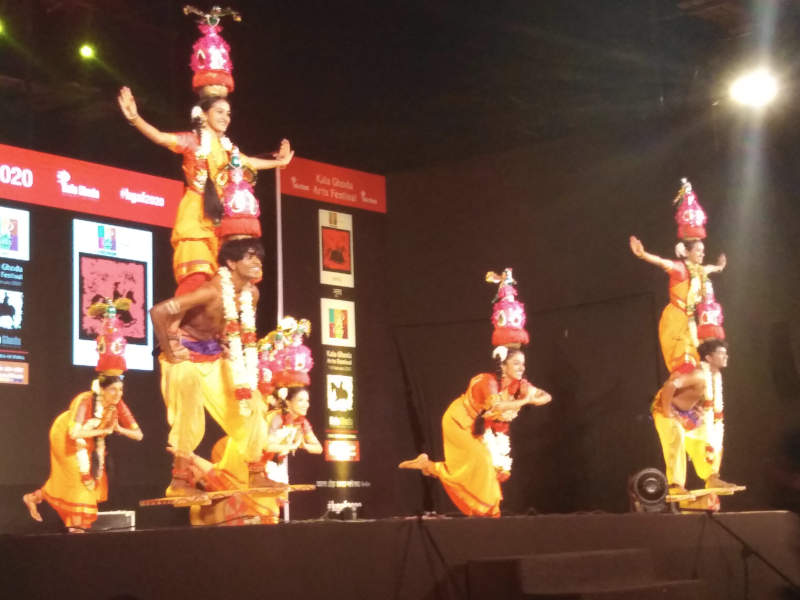
Tamil Nadu’s Karagaattam dance performed at Mumbai’s Kala Ghoda Arts Festival 2020
As Mumbaikars, we have attended this festival multiple times. Kala Ghoda Arts Festival or KGAF as it is called for short, is a cultural festival with dates set in stone. It is always from the first weekend of February to the second. Including the four days across the two weekends, the festival also runs for the entire week between the two weekends, thus making the festival 9 days long. Imagine the number of things you can catch if you were to attend all the 9 days. As freelancers, we have been able to do this every time the festival comes to town. The festival roughly covers 10 different categories and is held in several venues inside south Mumbai, spanning from Churchgate railway station to Colaba. The hub of the festival is Rampart Road (renamed to Kaikhushru Dubash Marg) in Kala Ghoda locality of south Mumbai. The road is completely shut for traffic during the duration of the festival. The road has two lanes, with shops lining both sides. The shops sell unique items such as handicrafts, interesting items of art, apparel and regional food & beverages. On the divider of the road, various art exhibits are showcased. Usually the exhibits are made of scrap material or simple elements such as threads, paper sheets, strands, discs, etc. Each exhibit tells you a story, such as pollution, divisive politics, women empowerment, addiction, etc.
Apart from Kala Ghoda area, here are the categories covered across multiple venues across south Mumbai.
- Dance and music: These take place in stages on open grounds in south Mumbai, e.g. Azad Maidan, Cross Maidan and Horniman circle lawn. Dance forms and musical instruments from all over India are covered, be it Kashmir or Tamil Nadu.
- Theatre: Plays happen either in open ground stages or inside auditoriums. The plays are usually in English, Marathi, Hindi and Gujarati (since Mumbai has a massive number from that community). Sometimes even Bhojpuri plays are scheduled. Other stage performances include stand-up comedies and mimes.
- Workshops: Interactive workshops are conducted for different topics, such as acting, improv, paper mache, clay models, human interaction, cooking, etc.
- Heritage walks: Walks are conducted in various areas of south Mumbai with stories from the Mumbai of 1600s.
- Photography and cinematography: Photo exhibitions are displayed and short art movies from various art schools and independent movie makers are screened here. Interesting movies from small communities in languages such as Armenian are also screened, along with English subtitles of course.
- For children: Special workshops and competitions are arranged for children of various age groups, such as for those from primary school to those who will soon be teenagers.
While extremely popular in the city, the festival is quite new and began only in 1999. This is an infancy compared to centuries-old festivals like Mysuru’s Navratri celebration and Chennai’s Margazhi Utsavam.
2. Upvan Lake Sanskruti Arts Festival, Thane, Maharashtra
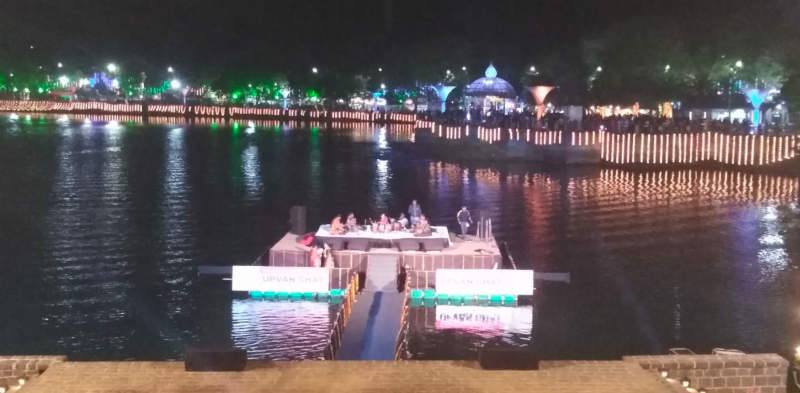
Floating stage inside Upvan Lake, Thane
We are adding a second cultural festival that happens around Mumbai, i.e. in its satellite city of Thane. While not as versatile as Kala Ghoda, the Sanskruti Arts Festival takes place in beautiful surroundings. The festival is simply referred to as Upvan Fest for convenience. This is because it happens around Thane’s Upvan lake, with the beautiful Yeoor Hiils as the backdrop. The road is closed for traffic during the 4 days of the festival, the dates of which vary between early and late February. The festival is usually from a Friday to the next Monday, with Saturdays and Sundays having the best of schedules with popular artistes.
The lake is decorated with coloured lights and looks dazzling. The road adjoining the lake to its west is lined with stalls, most of which is for food, but some of them specialise in handicrafts and apparel. A giant wheel (Ferris wheel) and amusement rides take up the northern bank of the lake. The entrance to the lake promenade is to the south of the lake. There are also larger-than-life-sized exhibits placed on this side. The main amphitheatre, one of the venues for performing arts, is near the entrance. A large playground to the east of the lake serves as an open ground venue with a large seating capacity. But the most eye-catching feature of the Upvan festival is also on the eastern bank, or rather INSIDE the lake near the eastern bank. A floating stage for performing artistes is arranged about 50 metres inside the lake, with a narrow approach way to reach it. The audience sits on the multi-level seating area on the bank of the lake facing the floating stage.
The main focus of Upvan Festival are songs, instruments and dances. Dances happen only in the southern amphitheatre and on the open ground, but not on the floating stage 🙂 The floating stage sees famous artistes from around India perform songs or instruments, along with their troupe.
3. Margazhi Utsavam, Chennai, Tamil Nadu
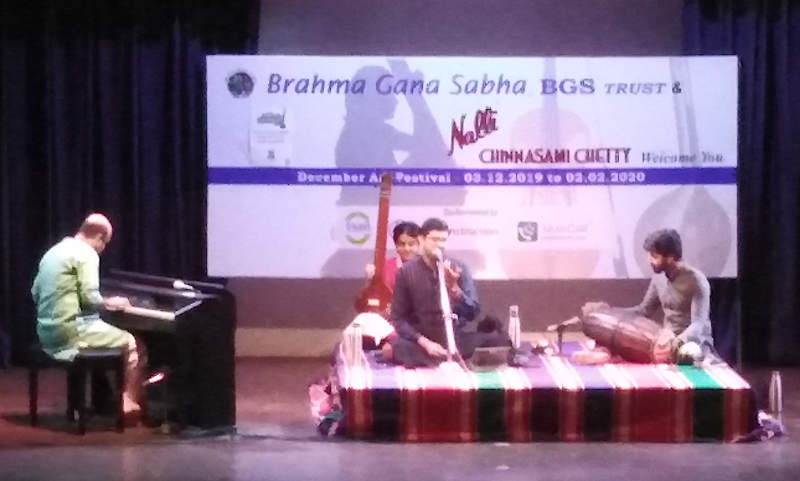
Lead artistes Sikkul Gurucharan (vocal) and Anil Srinivasan (keyboard) perform along with accompanying artistes (Tambura and Mridangam) through Brahma Gaana Sabha during Margazhi Utsavam 2020 at Sivagami Pethachi Hall, Mylapore, Chennai
Margazhi, called Margashish in Sanskrit-based languages, is the Hindu calendar month that spans December and January on the Gregorian calendar. It is the coldest month of the year, but the most pleasant one in Chennai. Margazhi month is supposed to be a month where people dedicate their life to prayer and spirituality. Marriages and family-level public ceremonies are put on hold during Margazhi month, and everyone turns to self-realisation.
Because it is a month dedicated to praise of God, the Margazhi music festival is a big thing in Chennai. Carnatic music takes centre stage as artistes pour in from all over Tamil Nadu, India and even abroad. Songs and instrumental music take up a big part of the festival, while dance recitals like Bharatnatyam form a small part. Dance performances come to the forefront after Pongal, when Margazhi ends and Thai month starts. The Chennai festival has given a platform and launched the careers of several famous Carnatic music luminaries. They continue to grace the festival with yearly performances, even though many of them stay abroad today.
The itinerary for Margazhi Utsavam is planned and executed by music ‘Sabhas’, which are committees of ex-artistes, and affluent connoisseurs from industries. Sabhas are found all around Chennai. During the 2020 fest, we counted 22 Sabhas arranging concerts. But most Sabhas, especially the oldest ones, are concentrated in localities like Mylapore (Thirumayilai), T Nagar, Alwarpet and Triplicane (Thiruvallikkeni). Some Sabhas like Naaradha Gaana Sabha, Mylapore Fine Arts Club and Parthasarthy Swamy Sabha have invested in their own performance halls. Others use school and college auditoriums for the duration of the festival. Performances are scheduled from 7 am in the morning with bhajan groups, all the way to 7 pm in the evening when the star performers take centre-stage. Most evening performances last until 8:30 pm or 9:00 pm. The new year eve performances draw large audiences.
During the last weekend of Margazhi music festival is the Mylapore festival, that happens on the four streets surrounding Mylapore’s Kapaleeshwara temple. There are stalls, open ground stage performances, heritage walks, food trail walks and photo exhibitions.
4. Navaratri – Dasara Utsava, Mysuru, Karnataka
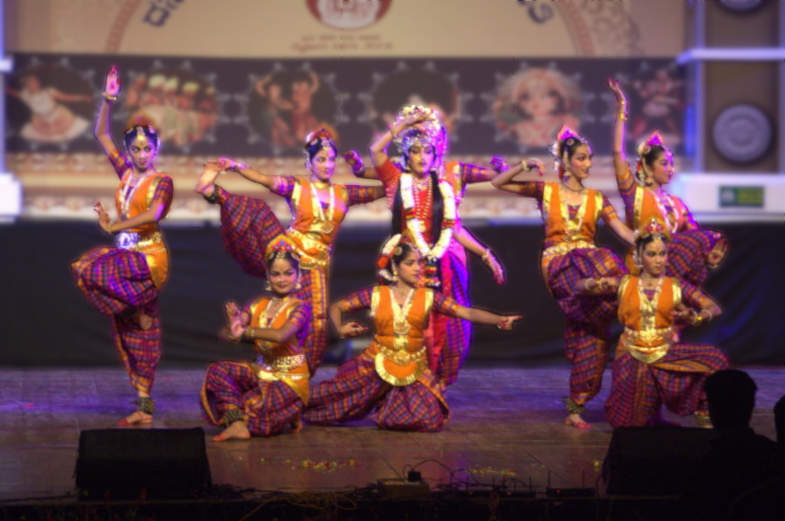
Bharatnatyam performance during Navaratri Utsava 2017 at Kala Mandira, Mysuru.
Navaratri brings the whole of India in celebration mode. Western India dances Dandiya , north India has Mata Vaishnodevi pandals, eastern India performs Durga processions and Tamil Nadu arranges doll collections called ‘golu’. But one of the best places to be during Navratri and Dasara is the royal city of Mysuru.
The Navaratri celebration in Mysuru is centuries old and has been funded regularly by Wodeyars and the affluent communities and companies in the city. Navaratri also has a special significance in the heart of every Mysorean. It is on a hill in this city that the Goddess Shakti appeared as Chamundi Devi and slayed the tyrant buffalo demon Mahishasura. That hill has Mysuru’s important Chamundi Devi temple today.
Just like Mumbai’s Kala Ghoda fest and Chennai’s Margazhi Utsavam, Mysuru’s Navaratri – Dasara Utsava takes place at multiple venues. The most spectacular stage is the front of Mysuru Wodeyar palace, which is beautifully lit up every evening. There are other stages such as Rangacharlu Hall (also simply called Town Hall) for sound and light shows and Kala Mandira for music and dance. Mysuru is a city of lawns, so there are several flower shows during Navaratri. A very unique show we saw was an exhibition on RC-controlled mini planes. These planes were flown above the ground in front of Lalita Mahal palace at the base of Chamundi hill.
As an anecdote, we were very happy to see authentic Punjabi Bhangra dance performed by a proper Punjab-based troupe, using their own singer to sing folk songs, most of which were light-hearted jokes on the members of a family. The members of the troupe also wore authentic cotton Punjabi attire with no extra frills. If you see the so-called ‘Bhangra’ performances in commercial cities like Mumbai, Pune, New Delhi or Bengaluru, you will find performers wearing extra-shiny non-cotton attire. They dance to Bollywood / Indipop / remix songs that are not Punjabi folk music, but pop music with Punjabi lyrics. Plenty of these songs are about getting drunk and wasted, the typical Honey Singh type and not representative of the real Punjab at all.
On the last (10th) day of the festival, i.e. Dasara, a huge procession makes its way from Banni Mantapa to the top of Chamundi hill. At the end of this procession is a herd of elephants, the most senior one having the honour of carrying the idol of Maa Chamundi Devi on its back.
5. Dharmasthala Navaratri – Dasara Utsava, Dharmasthala, Karnataka
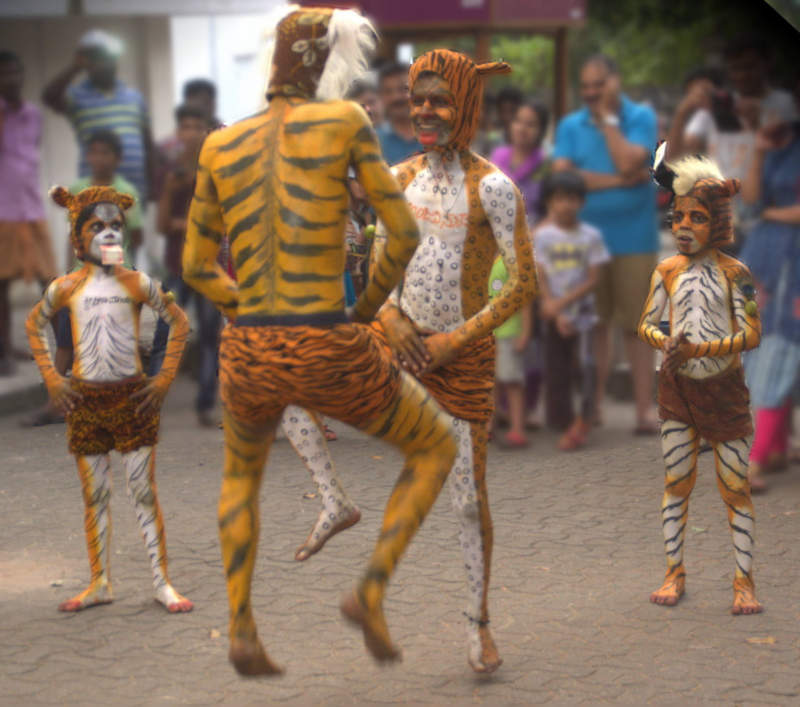
Street performance at Navaratri Utsava 2017, Dharmasthala
Dharmasthala is a small town in Karnataka’s Dakshina Kannada district. Because of its Dharmasthala temple complex, it has plenty of tourists who stay in the various Yatri Niwas lodges inside the town. Dharma Sthala translates to the Place of Religion, which refers to the Hindu religion. The temple complex has several shrines inside for the multiple branches of Hinduism, such as Shaivism and Vaishnavism. The temple also offers lunch and dinner as prasada, similar to the Langar system of Gurudwaras.
While accommodation is enough for pilgrims, Dharmasthala is too small to organise a multi-cultural, multi-day festival capable of accommodating tens of thousands of people. Also, it is hard to get the most famous artistes to come to Dharmasthala, when most of them would prefer to go to Mysuru during Navaratri. As a result, Dharmasthala Navaratri Utsava is scaled down and hyperlocal. The performances happen at a stage built in front of the temple complex. The announcers present only in Kannada (which we understood only partially) and singers sing devotional songs in Sanskrit, Kannada, Tulu and Telugu. The songs are mostly Carnatic.
While not as glamorous as Kala Ghoda or Margazhi, there is an authenticity about the small festival and it offers surprising variety. We saw song performances and folk dance forms such as Yakshagana. There were also street percussion bands using local drum-like instruments. Dancers with their bodies painted in colours of the wild cat family (tiger, leopard, etc) were dancing to the beats of percussion.
6. Ganesh festival, Maharashtra
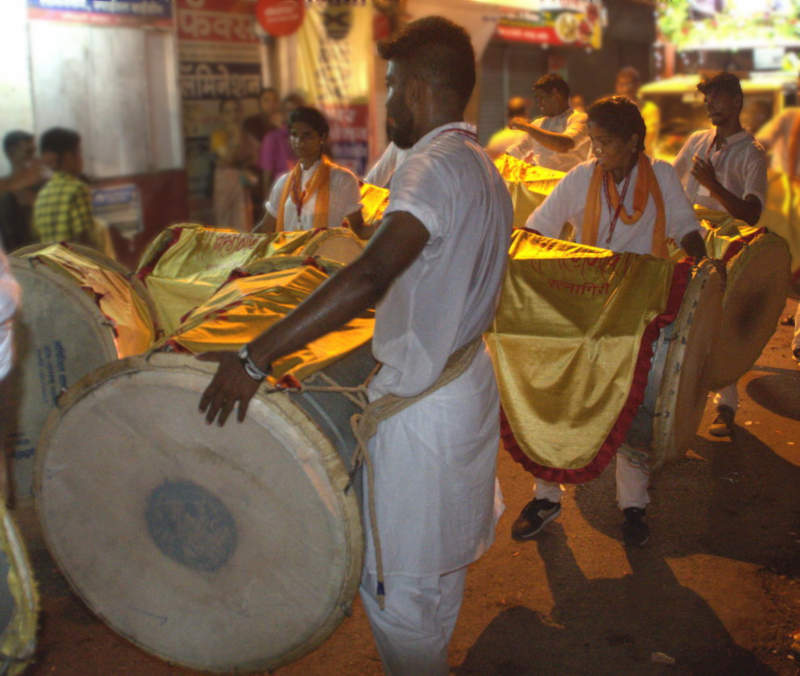
A traditional Nashik-dhol style percussion band performs at Ratnagiri’s Ganesh festival of 2017
While not organised and curated by committees as a city-wide event, Ganesh festival is a series of individual celebrations, each organised by a family or a Mandal (an organising committee that usually is an entire housing society). During India 360 we caught the celebrations at Ratnagiri city of Maharashtra. But similar celebrations happen in Mumbai and Pune. You can see Lord Ganesha idols created and decorated in different forms presented on Chaturthi and then immersed in a nearby lake, river or sea on Chaturdashi. The most energetic celebrations are the coordinated and highly synchronised percussion bands that play famous tracks like the Nashik Dhol.
7. Shirui Lily Festival, Ukhrul, Manipur
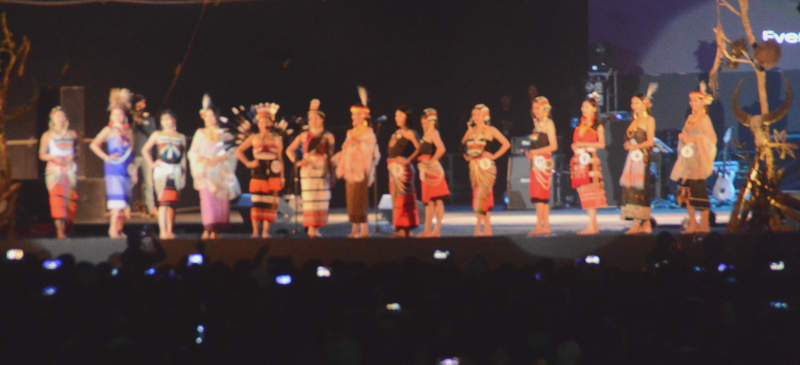
Contestants at Miss Spring 2018 represented 18 different tribes from Manipur during Shirui Lily Festival 2018, Ukhrul, Manipur
If you want to attend a cultural festival in the north-east, then the Shirui festival happening in April is a good option. It happens at Ukhrul town, the home of the Tangkhul tribe. To the east of the town, bordering Myanmar, is the Shirui peak (Shirui Kashong in Tangkhul language). During the spring season, the slopes of the peak are abound with a species of lily flower that is native to this area. Hence the cultural festival of this region to welcome the spring season is named the Shirui Lily festival.
There are two performance venues in Ukhrul. One is the town square, where a stage is created. The town square also houses many shops that sell local food, locally brewed beer, paintings, bamboo products and utensils made of black stone, that is unique to this district. On the stage in the town square, you can see folk dance and songs from around north-eastern states and also a few from around India. Another stage is an open ground just outside the town entrance. Two events happen here. One is a rock music event called ShiRock, where rock music talent from around north-east can be enjoyed. The other one is a beauty pageant named Miss Spring, eligible for women from around Manipur, as they represent their respective tribes.
Conclusion
And thus, we have listed the 7 cultural festivals that we covered around India. These are some festivals you should check out if you happen to be visiting that place at the right time. It is impossible to cover every cultural fest in India within a year or even within half a decade. You should stay aware of what happens in every region during a particular season and make a list. Then you can plan your trips accordingly and learn more about India through its cultural fests.

